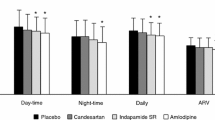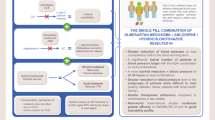Abstract
Despite extensive debate about the first choice for treating essential hypertension, monotherapy effectively normalizes blood pressure (BP) values in only a limited number of hypertensive patients. Thus, the aim of combination therapy should always be to both improve BP control and to reduce cardiovascular events. Antihypertensive drugs can be effectively combined if they have different and complementary mechanisms of action. This is crucial to obtain additive BP-lowering effects without impacting on tolerability. One typical combination is the association of drugs blocking and stimulating the renin–angiotensin system (RAS) (angiotensin-converting enzyme [ACE] inhibitor or angiotensin receptor blocker and calcium antagonist or diuretic, respectively). In contrast, some combinations (e.g., calcium antagonists plus diuretics or beta-blockers plus RAS blockers) have no additive BP-lowering effects, while other combinations (e.g., clonidine plus alpha-1 receptor blockers) can have a negative interaction. Regardless, BP reduction is not the only mechanism that reduces cardiovascular risk. Scientific evidence indicates that some drug classes are better than others in this respect, and therefore some drug combinations are also better than others. The results of the ASCOT-BPLA and ACCOMPLISH trials suggested that an ACE inhibitor/calcium antagonist combination had better cardioprotective effects than beta-blocker/diuretic or ACE inhibitor/diuretic combinations. It is worth noting that no controlled clinical trials have used hard endpoints when investigating the effects of an angiotensin receptor blocker/calcium antagonist combination. In conclusion, combination therapy is needed for optimal antihypertensive management, with the first choice being an ACE inhibitor plus a calcium antagonist. This approach should improve BP control and provide better cardiovascular protection.





Similar content being viewed by others
References
Lopez AD, Mathers CD, Ezzati M, et al. Global and regional burden of disease and risk factors, 2001: systematic analysis of population health data. Lancet. 2006;367(9524):1747–57.
Kotseva K, Wood D, De Backer G, et al. Cardiovascular prevention guidelines in daily practice: a comparison of EUROASPIRE I, II, and III surveys in eight European countries. Lancet. 2009;373(9667):929–40.
Ezzati M, Lopez AD, Rodgers A, et al. Selected major risk factors and global and regional burden of disease. Lancet. 2002;360(9343):1347–60.
Lewington S, Clarke R, Qizilbash N, et al. Age-specific relevance of usual blood pressure to vascular mortality: a meta-analysis of individual data for one million adults in 61 prospective studies. Lancet. 2002;360(9349):1903–13.
Mancia G, Fagard R, Narkiewicz K, Redon J, Zanchetti A, Bohm M, Christiaens T, Cifkova R, De Backer G, Dominiczak A, Galderisi M, Grobbee DE, Jaarsma T, Kirchhof P, Kjeldsen SE, Laurent S, Manolis AJ, Nilsson PM, Ruilope LM, Schmieder RE, Sirnes PA, Sleight P, Viigimaa M, Waeber B, Zannad F. 2013 ESH/ESC Guidelines for the management of arterial hypertension—The Task Force for the management of arterial hypertension of the European Society of Hypertension (ESH) and of the European Society of Cardiology (ESC).
Corrao G, Nicotra F, Parodi A, Zambon A, Heiman F, Merlino L, Fortino I, Cesana G, Mancia G. Cardiovascular protection by initial and subsequent combination of antihypertensive drugs in daily life practice. Hypertension. 2011;58(4):566–72.
Gradman AH, Parisé H, Lefebvre P, et al. Initial combination therapy reduces the risk of cardiovascular events in hypertensive patients: a matched cohort study. Hypertension. 2013;61:309–18.
Kaplan NM, Flynn JT. Kaplan’s clinical hypertension. 9th ed. Philadelphia: Lippincot Williams & Wilkins; 2006. p. 1–518.
Julius S, Kjeldsen SE, Weber M, Brunner HR, Ekman S, Hansson L, Hua T, Laragh J, McInnes GT, Mitchell L, Plat F, Schork A, Smith B, Zanchetti A, VALUE trial group. Outcomes in hypertensive patients at high cardiovascular risk treated with regimens based on valsartan or amlodipine: the VALUE randomised trial. Lancet. 2004;363:2022–31.
Salvetti A, Magagna A, Innocenti P, Cagianelli A, Cipriani M, Gandolfi E, Del Prato C, Ballestra AM, Saba P, Giuntoli F, et al. Chlorthalidone does not increase the hypotensive effect of nifedipine in essential hypertensives: a crossover multicentre study. J Hypertens Suppl. 1989;7:S250–1.
ALLHAT Officers and Coordinators for the ALLHAT Collaborative Research Group. The Antihypertensive and Lipid-Lowering Treatment to Prevent Heart Attack Trial. Major outcomes in high-risk hypertensive patients randomized to angiotensin-converting enzyme inhibitor or calcium channel blocker vs diuretic: The Antihypertensive and Lipid-Lowering Treatment to Prevent Heart Attack Trial (ALLHAT). JAMA. 2002;288:2981–97.
Makani H, Bangalore S, Desouza KA, Shah A, Messerli FH. Efficacy and safety of dual blockade of the renin–angiotensin system: meta-analysis of randomised trials. BMJ. 2013;346:360–74.
Weinberger MH. Blood Pressare and metabolic responses to hydrochlorothiazide, captopril and the combination in black and white mild-to-moderate hypertensive patients. J Cardiovasc Pharmacol. 1985;7(suppl 6):S22–5.
Makani H, Bangalore S, Romero J, Wever-Pinzon O, Messerli FH. Effect of renin–angiotensin system blockade on calcium channel blocker-associated peripheral edema. Am J Med. 2011;124:128–35.
National Institute for Health and Clinical Excellence. Hypertension: clinical management of primary hypertension in adults (update). (Clinical guideline 127). 2011. http://guidance.nice.org.uk/CG127. Accessed Aug 2011
James PA, Oparil S, Carter BL, Cushman WC, Dennison-Himmelfarb C, Handler J, Lackland DT, LeFevre ML, MacKenzie TD, Ogedegbe O, Smith SC Jr, Svetkey LP, Taler SJ, Townsend RR, Wright JT Jr, Narva AS, Ortiz E. 2014 Evidence-based guideline for the management of high blood pressure in adults: report from the panel members appointed to the Eighth Joint National Committee (JNC 8). JAMA. 2014;311:507–20.
Dahlöf B, Sever PS, Poulter NR, ASCOT Investigators, et al. Prevention of cardiovascular events with an antihypertensive regimen of amlodipine adding perindopril as required versus atenolol adding bendroflumethiazide as required, in the Anglo-Scandinavian Cardiac Outcomes Trial-Blood Pressure Lowering Arm (ASCOT-BPLA): a multicentre randomised controlled trial. Lancet. 2005;366:895–906.
Dahlof B, Devereux RB, Kjeldsen SE, Julius S, Beevers G, de Faire U, Fyhrquist F, Ibsen H, Kristiansson K, Lederballe-Pedersen O, Lindholm LH, Nieminen MS, Omvik P, Oparil S, Wedel H. Cardiovascular morbidity and mortality in the Losartan Intervention For Endpoint reduction in hypertension study (LIFE): a randomised trial against atenolol. Lancet. 2002;359:995–1003.
Jamerson K, Weber MA, Bakris GL, Dahlo B, Pitt B, Shi V, Hester A, Gupte J, Gatlin M, Velazquez EJ, ACCOMPLISH Trial Investigators. Benazepril plus amlodipine or hydrochlorothiazide for hypertension in high-risk patients. N Engl J Med. 2008;359:2417–28.
Bertrand ME, Ferrari R, Remme WJ, Simoons ML, Deckers JW, Fox KM, EUROPA Investigators. Clinical synergy of perindopril and calcium-channel blocker in the prevention of cardiac events and mortality in patients with coronary artery disease. Post hoc analysis of the EUROPA study. Am Heart J. 2010;159:795–802.
van Vark LC, Bertrand M, Akkerhuis KM, et al. Angiotensin-converting enzyme inhibitors reduce mortality in hypertension: a meta-analysis of randomized clinical trials of renin–angiotensin–aldosterone system inhibitors involving 158,998 patients. Eur Heart J. 2012;33:2088–97.
Savarese G, Costanzo P, Cleland JG, et al. A meta-analysis reporting effects of angiotensin-converting enzyme inhibitors and angiotensin receptor blockers in patients without heart failure. J Am Coll Cardiol. 2013;61:131–42.
Wu HY, Huang JW, Lin HJ, Liao WC, Peng YS, Hung KY, Wu KD, Tu YK, Chien KL. Comparative effectiveness of renin–angiotensin system blockers and other antihypertensive drugs in patients with diabetes: systematic review and bayesian network meta-analysis. BMJ. 2013;24(347):f6008–23.
Cheng J, Zhang W, Zhang X, Han F, Li X, He X, Li Q, Chen J. Effect of angiotensin-converting enzyme inhibitors and angiotensin II receptor blockers on all-cause mortality, cardiovascular deaths, and cardiovascular events in patients with diabetes mellitus: a meta-analysis. JAMA Intern Med. 2014;174:773–85.
Ruschitzka F, Taddei S. Angiotensin-converting enzyme inhibitors: first-line agents in cardiovascular protection? Eur Heart J. 2012;33:1996–8.
Doggrell SA. Is amlodipine the best initial monotherapy for hypertension? Expert Opin Pharmacother. 2006;7:829–32.
Epstein BJ, Vogel K, Palmer BF. Dihydropyridine calcium channel antagonists in the management of hypertension. Drugs. 2007;67:1309–27.
Mason RP, Marche P, Hintze TH. Novel vascular biology of third-generation L-type calcium channel antagonists: ancillary actions of amlodipine. Arterioscler Thromb Vasc Biol. 2003;23:2155–63.
Terpstra WF, May JF, Smit AJ, de Graeff PA, Havinga TK, van den Veur E, Schuurman FH, Meyboom-de Jong B, Crijns HJ. Long-term effects of amlodipine and lisinopril on left ventricular mass and diastolic function in elderly, previously untreated hypertensive patients: the ELVERA trial. J Hypertens. 2001;19:303–9.
Pitt B, Byington RP, Furberg CD, Hunninghake DB, Mancini GB, Miller ME, et al. Effect of amlodipine on the progression of atherosclerosis and the occurrence of clinical events. PREVENT Investigators. Circulation. 2000;102(13):1503–10.
Jorgensen B, Simonsen S, Endresen K, Forfang K, Vatne K, Hansen J, Webb J, Buller C, Goulet G, Erikssen J, Thaulow E. Restenosis and clinical outcome in patients treated with amlodipine after angioplasty: results from the Coronary AngioPlasty Amlodipine REStenosis Study (CAPARES). J Am Coll Cardiol. 2000;35:592–9.
Nissen SE, Tuzcu EM, Libby P, Thompson PD, Ghali M, Garza D, Berman L, Shi H, Buebendorf E, Topol EJ, CAMELOT Investigators. Effect of antihypertensive agents on cardiovascular events in patients with coronary disease and normal blood pressure: the CAMELOT study: a randomized controlled trial. JAMA. 2004;292:2217–25.
Poole-Wilson PA, Lubsen J, Kirwan BA, van Dalen FJ, Wagener G, Danchin N, Just H, Fox KA, Pocock SJ, Clayton TC, Motro M, Parker JD, Bourassa MG, Dart AM, Hildebrandt P, Hjalmarson A, Kragten JA, Molhoek GP, Otterstad JE, Seabra-Gomes R, Soler-Soler J, Weber S, A Coronary disease Trial Investigating Outcome with Nifedipine gastrointestinal therapeutic system investigators. Effect of long-acting nifedipine on mortality and cardiovascular morbidity in patients with stable angina requiring treatment (ACTION trial): randomized controlled trial. Lancet. 2004;364:849–57.
Dzau VJ, Bernstein K, Celermajer D, et al. Pathophysiologic and therapeutic importance of tissue ACE: a consensus report. Cardiovasc Drugs Ther. 2002;16:149–60.
Giannarelli C, Virdis A, De Negri F, Magagna A, Duranti E, Salvetti A, Taddei S. Effect of sulfaphenazole on tissue plasminogen activator release in normotensive subjects and hypertensive patients. Circulation. 2009;119:1625–33.
DiNicolantonio JJ, Lavie CJ, O’Keefe J. Not all angiotensin-converting enzyme inhibitors are equal: focus on ramipril and perindopril. Postgrad Med. 2013;125:154–68.
Yusuf S, Sleight P, Pogue J, Bosch J, Davies R, Dagenais G. Effects of an angiotensin-converting-enzyme inhibitor, ramipril, on cardiovascular events in high-risk patients. The Heart Outcomes Prevention Evaluation Study Investigators. N Engl J Med. 2000;342:145–53.
Taddei S, Bruno RM, Ghiadoni L. The correct administration of antihypertensive drugs according to the principles of clinical pharmacology. Am J Cardiovasc Drugs. 2011;11(1):13–20.
Ghiadoni L, Versari D, Magagna A, Kardasz I, Plantinga Y, Giannarelli C, Taddei S, Salvetti A. Ramipril dose-dependently increases nitric oxide availability in the radial artery of essential hypertension patients. J Hypertens. 2007;25:361–6.
Lonn E, Yusuf S, Dzavik V, Doris C, Yi Q, Smith S, Moore-Cox A, Bosch J, Riley W, Teo K, SECURE Investigators. Effects of ramipril and vitamin E on atherosclerosis: the study to evaluate carotid ultrasound changes in patients treated with ramipril and vitamin E (SECURE). Circulation. 2001;103:919–25.
Fox KM, EURopean trial On reduction of cardiac events with Perindopril in stable coronary Artery disease Investigators. Efficacy of perindopril in reduction of cardiovascular events among patients with stable coronary artery disease: randomised, double-blind, placebo-controlled, multicentre trial (the EUROPA study). Lancet. 2003;362:782–8.
Braunwald E, Domanski MJ, Fowler SE, Geller NL, Gersh BJ, Hsia J, Pfeffer MA, Rice MM, Rosenberg YD, Rouleau JL, PEACE Trial Investigators. Angiotensin-converting-enzyme inhibition in stable coronary artery disease. N Engl J Med. 2004;351:2058–68.
Pitt B, O’Neill B, Feldman R, Ferrari R, Schwartz L, Mudra H, Bass T, Pepine C, Texter M, Haber H, Uprichard A, Cashin-Hemphill L, Lees RS, QUIET Study Group. The QUinapril Ischemic Event Trial (QUIET): evaluation of chronic ACE inhibitor therapy in patients with ischemic heart disease and preserved left ventricular function. Am J Cardiol. 2001;87:1058–63.
Conflicts of interest
No external funding was used in the preparation of this review. The author has received research Grants from Boehringer Ingelheim, Novartis, Servier, and Menarini, and speaker fees from Servier, Stroder, Pfizer, Boheringer Ingelheim, and Sigma Tau.
Author information
Authors and Affiliations
Corresponding author
Rights and permissions
About this article
Cite this article
Taddei, S. Combination Therapy in Hypertension: What Are the Best Options According to Clinical Pharmacology Principles and Controlled Clinical Trial Evidence?. Am J Cardiovasc Drugs 15, 185–194 (2015). https://doi.org/10.1007/s40256-015-0116-5
Published:
Issue Date:
DOI: https://doi.org/10.1007/s40256-015-0116-5




